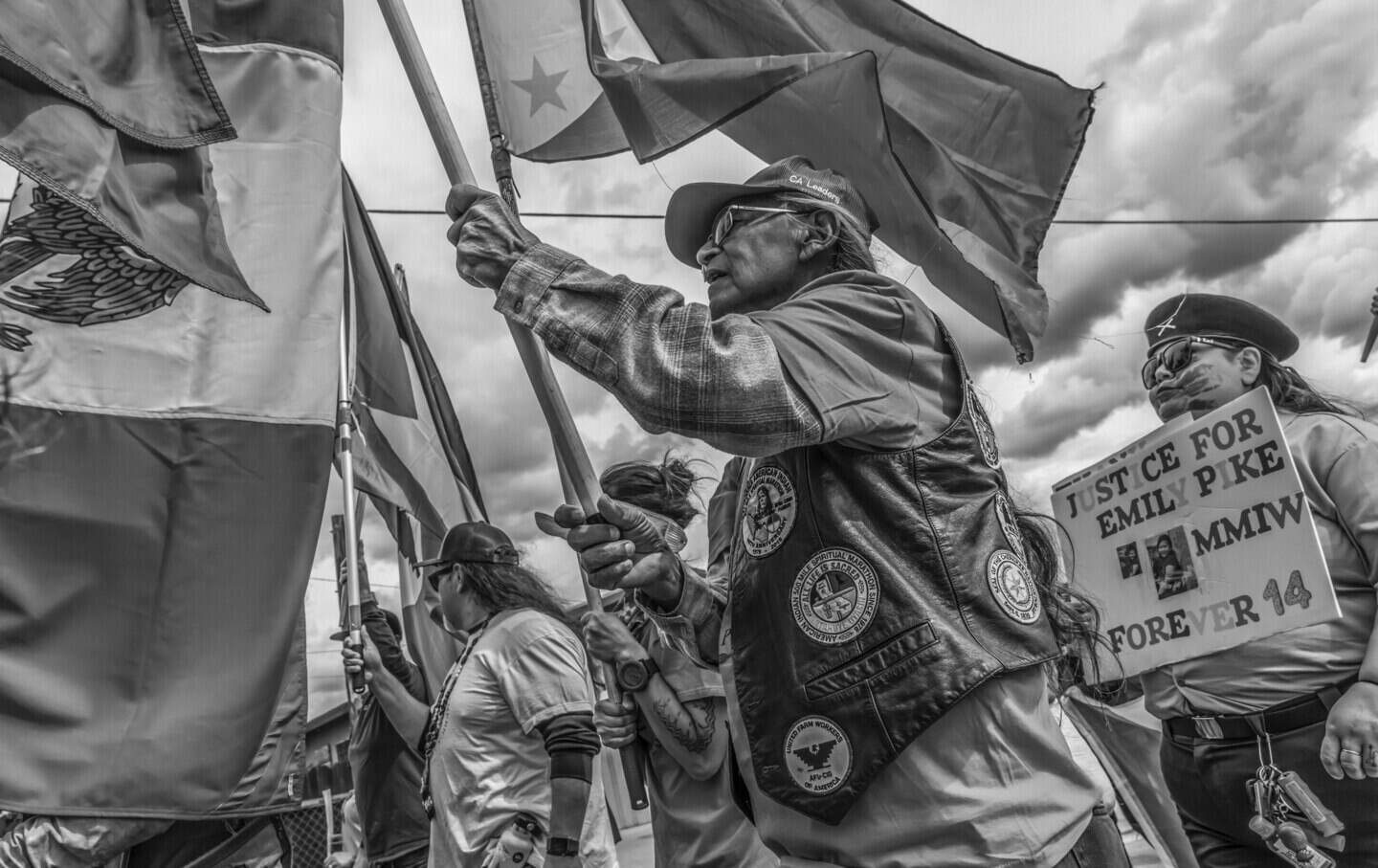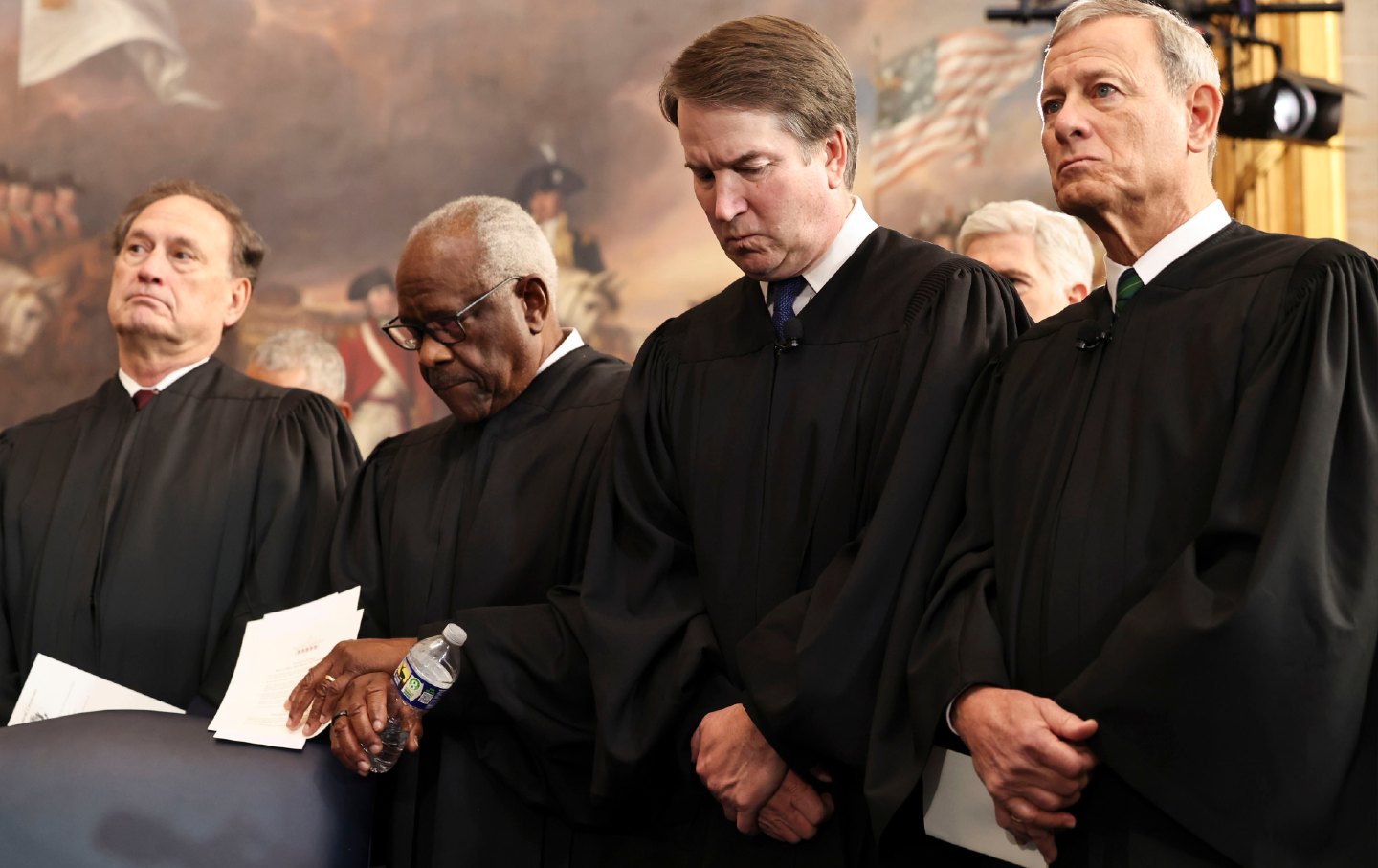Trump’s Guantánamo Plan Will Be a Costly, Morally Bankrupt Fiasco
The US government has begun to shuttle immigrants from the United States to Gitmo, post photos of them in shackles, and lock them away.

The Department of Homeland Security released photos on February 4 of the first flight of migrants to Guantánamo Bay, Cuba.
(Department of Homeland Security)
President Donald Trump caught the Pentagon off-guard when he announced late last month that he would be expanding the migrant holding facility at Guantánamo Bay to “detain the worst criminal illegal aliens threatening the American people.” Since then, the administration has begun to shuttle immigrants from the United States to the base aboard military planes, post photos of them in shackles arriving at Guantánamo’s airstrip, and lock them away in a facility previously used to incarcerate War on Terror detainees. Across the bay, Navy and Coast Guard forces have started erecting a tent city, presumably to hold thousands of other noncitizens the administration has promised to send to the base in the coming weeks.
While shipping immigrants from the United States to Guantánamo is new, using the base to detain migrants is not. I’ve interviewed more than a hundred asylum seekers who were held at the naval station during the 1990s. I’ve walked the exterior of the Migrant Operations Center and the Mass Migration Complex that are the subject of Trump’s order to expand detention capacity at the base. From what I can see, Trump’s proposal is a bet on no-oversight immigration detention and a branding campaign designed to make immigrants appear as threatening as the War on Terror captives still held in Guantánamo’s prison complex. Despite the bluster with which the administration has rolled out the proposal, it’s a bet that’s not likely to pay off in the way the administration thinks it will.
To explain why this wager is reckless—even on Trump’s own cruel terms—let me begin with the base’s history as a site for detaining asylum seekers. The United States has held Haitians at Guantánamo on and off since the 1970s, though a formal policy of processing asylum seekers began only in 1991, and an early iteration of the Migrant Operations Center, the facility mentioned in Trump’s recent memorandum, has existed since 1996. No immigrants detained as part of civil removal proceedings, however, have ever been sent to Guantánamo from the United States. Still, when Secretary of Defense Pete Hegseth called Guantánamo “the perfect spot” for the new detention mission, he was leaning heavily on this history.
The Migrant Operations Center, or MOC, is a small facility on the leeward side of the base with a maximum capacity of 120, although it typically houses a much smaller population of asylum seekers who are, in rare instances, held at the base after being stopped at sea by the US Coast Guard. It has been described to me as looking like a small barracks with claustrophobic, prison-like rooms. I say “described,” because, although I’ve walked around the fence line of the MOC, the Immigration and Customs Enforcement officials in charge were so sensitive about revealing any details that they wouldn’t allow an agency representative or their contractors to discuss it with me, let alone provide a tour. One of the naval station’s public-affairs officers was baffled by the level of secrecy, especially given that the Joint Task Force that runs the War on Terror detention complex did, at that time, permit such tours for visitors to examine the cells and grounds of its camps. This is in part what’s so troubling about the MOC—a near paranoid desire to keep all that happens there hidden away.
A stone’s throw away from the MOC is the much larger Mass Migration Complex, which, when I was there in 2017, was slated for an expansion meant to accommodate more than 12,000 migrants during a mass migration event from Haiti or Cuba. Under “surge conditions,” the Complex would supposedly hold as many as 19,000 asylum seekers. Under those plans, increasing the number of beds from 12,000 to 19,000 would mean nearly doubling the “normal” capacity of the tents, cramming them with 20 migrants apiece.
Trump and Hegseth have talked about expanding the MOC, but what they mean, I believe, is that they plan to use both the Center and the Mass Migration Complex. During normal conditions, the Complex is little more than an empty field with some rudimentary camp infrastructure. But when needed, it can be outfitted with tents and cots to temporarily accommodate large numbers of immigrants, although not the 30,000 figure administration officials have been repeating. Navy service members are currently working to set up a tent city on the site of the complex. At the same time, the Department of Homeland Security has locked the first groups of detainees away in Camp 6, one of the War on Terror detention facilities on the windward side of the base, and at another, currently undisclosed, site at the base.
The use of Camp 6 brings us to the other reason the Trump administration is cleaving to Guantánamo as a “perfect” place to detain immigrants. The base is a powerful symbol in the administration’s intensifying propaganda around the necessity of militarized border enforcement. For boomers, Guantánamo radiates Cold War vibes: the Bay of Pigs, the Cuban missile crisis, and, more generally, an aura of hypermasculine martial toughness, embodied best perhaps in the condescending swagger of Jack Nicholson’s Colonel Nathan Jessep in the 1992 film A Few Good Men.
For younger generations, Guantánamo brings to mind the George W. Bush administration’s willingness to abandon the rule of law and its embrace of the “dark side,” as Dick Cheney put it in the days following 9/11. Guantánamo was advertised as a legal black hole where the CIA could send the “worst of the worst,” in the words of former Secretary of Defense Donald Rumsfeld, and where the alleged mastermind of the 9/11 attacks, Khalid Sheikh Mohammed, remains imprisoned to this day.
Lumping immigrant detainees in with enemy combatants by sending them to Guantánamo is clearly calculated to amplify the administration’s message that “true” US citizens, those who trace their nationality via descent, not birthright, are beset by an invading army of criminal aliens. Echoing Rumsfeld, Secretary of Defense Pete Hegseth has described the immigrants slated for transfer to Guantánamo as the “worst of the worst,” signaling to the American public that when it comes to immigration, we should be on the same war footing as we were after 9/11. Trump’s immigration policy architects have been repeating this battle cry for some time, and the expansion of Guantánamo as a detention site for immigrants distills the “immigration as war” messaging in a potent symbol of aggressive militarization.
Given the budget-slashing measures that the administration has been ruthlessly and recklessly pursuing through the Department of Government Efficiency these past few weeks, one might wonder what the monetary cost of all this will be? After all, the prison complex for War on Yerror detainees at Guantánamo is one of the most expensive in the world, with a price tag per detainee of more than $10 million per year, more than 128 times the cost of holding a person in a maximum security prison in the United States.
The bill is going to be shocking, but my guess is that the Department of Defense has little sense of what the full tally will be at this point. While officials from the US Southern Command and the Department of Homeland Security have a history of gaming out the expansion of the Mass Migration Complex, any projected costs they are working with likely do not include transporting tens of thousands of detained immigrants from across the United States and incarcerating them in both camp- and prison-style settings at Guantánamo.
Whatever the total cost to hold detainees at the base is, there are also serious legal issues that will fuel challenges sufficiently robust for federal district court judges to intervene. One major issue is whether ICE has any authority to detain immigrants at Guantánamo after flying them there from the United States. ICE’s detention authority comes from specific provisions in the Immigration and Nationality Act that most federal court judges and even the administration’s lawyers are highly unlikely to interpret as applying outside US territory. Guantánamo, as the government has been arguing for decades, is not technically US soil.
Popular
“swipe left below to view more authors”Swipe →Setting aside the reach of the statutory detention power for a moment, the peculiar jurisdictional status of Guantánamo means that by taking immigrants with removal orders there, the US government would technically be deporting them, adding another argument for why officials would no longer have the authority to hold them. Hegseth can talk all he wants about the history of migrant detention at the base, but past operations are not good precedents, because those programs dealt with detainees who were attempting to enter the United States by sea in order to seek refuge, not those who have lived in the United States and then been ordered removed.
While the Supreme Court has held that Guantánamo is not de jure sovereign territory, it has also held that federal court jurisdiction extends to the base to review government authority to detain people there. It’s possible, though, that government officials think they’re more insulated from legal challenges than they actually are, which has, of course, long been part of Guantánamo’s appeal as a detention site. In 2017, I spoke with a former Obama administration official who had visited the MOC and was shocked to be presented with a briefing booklet that described Guantánamo as a “land without law.” As a legal matter, the statement is dead wrong, and while administration attorneys are sure to cook up some justification for their authority to detain immigrants brought from the United States to the base, US federal court jurisdiction exists to review those arguments.
To be sure, there will be ferocious resistance to Trump’s Guantánamo plan on the part of civil liberties advocates with considerable experience successfully litigating detention issues at the base going back to the early 1990s. A New Mexico District Court judge has already issued a temporary restraining order to prevent the transfer of a group of detainees from the Otero County Processing Center to Guantánamo Bay. The ACLU, Americans for Immigrant Justice, and the Center for Constitutional Rights have also filed a petition in the DC District Court, seeking access to clients detained incommunicado at the base. These lawsuits will almost certainly develop into coordinated efforts to challenge the president’s authority to relocate immigrants to Guantánamo and to ensure that the detention facilities themselves do not remain the black hole that the administration may imagine them to be.
Given these legal hurdles, it’s very likely that a federal court will either shut down this whole operation soon or that it will do so at some point down the road once thousands of immigrants have already been moved there, but only after hundreds of millions of taxpayer dollars have been wasted. If the first scenario comes to pass, the Guantánamo proposal will fade from memory, a flash in the pan among other ill-considered and poorly executed moves during the administration’s first 100 days. With the second scenario, Trump and Hegseth will find themselves with an expensive and embarrassing policy failure on their hands. And that’s not even taking into account the moral costs of a policy driven by punitive, anti-immigrant bigotry.
While the administration will face serious hurdles in the district courts and the courts of appeal, it’s worth asking how important those victories will be if the real fight is at the level of the Supreme Court. The question is especially fraught given that the court’s always fragile reputation as an oracular arbiter of impartial judicial reason has given way to that of a blatantly conservative political entity in the wake of recent decisions overturning longstanding precedent. Add to the mix the court’s long history of deferring to executive power when it comes to “foreign affairs,” and it’s easy to see why it would be hard to be sanguine about the court in this instance.
And yet, there’s reason to be hopeful on this front as well. Yes, it’s true that Guantánamo’s popular associations with the War on Terror and, to a lesser degree, international refugee crises in the Caribbean, might give the impression that any lawsuit challenging immigrant detention at the base would involve the foreign-affairs domain in which the balance of power between the courts and the presidency has historically tipped in favor of the latter. At the same time, we’re talking about immigrants who are present in the United States and who have Fifth Amendment protections under the Constitution. The decision to whisk thousands of them off to Guantánamo does not implicate the type of presidential powers the court typically favors.
More on Trump’s war on migrants:
The Trump administration has also made no effort to show that it actually lacks space on domestic military bases to pursue its detention agenda at home, undermining any sense of urgency officials might rely on when justifying such a dubious plan. If the administration needs more beds for its intended mass deportations, why turn to a small, distant outpost in the Caribbean that will be plagued by expensive logistics supply chain issues and strains on its limited physical plant? Again, the appeal of Guantánamo seems to be the mistaken idea that it is insulated from the scrutiny of the courts and the hope that the theatrics of detaining people alongside War on Terror detainees will be effective as a piece of bellicose political messaging. In other words, this is not a real foreign-affairs debacle but, rather, a transparent attempt on the part of the Trump administration to manufacture one. It’s hardly the kind of “international” crisis the court is more typically hesitant to wade into.
Will a majority of the Supreme Court look favorably on the administration’s decision to move and hold thousands of people outside of its jurisdiction without any clear statutory authority to do so? Even for this court, the tenuous legal foundations of the policy ought to be a hard sell, and, at the very least, should restrain the justices from staying lower-court rulings as the case proceeds. Of course, there’s always the possibility the administration will simply disregard court rulings altogether, but that would provoke a full-blown constitutional crisis.
In short, this Guantánamo detention proposal is not the straightforward, risk-free solution Trump and Hegseth are making it out to be. As the administration moves forward with the plan, the Department of Homeland Security is going to be mired in legal battles that will most likely end in the administration’s forced retreat on significant elements, if not all, of its Guantánamo policy, hardly the muscular look Trump wants to project.
In the process, Trump and his lackeys are going to waste a lot of money. While I have little hope that the president and the secretary of defense will be swayed by pleas for compassion or respect for the rule of law, the prospect of squandering hundreds of millions, if not billions, in taxpayer dollars on a likely unlawful political stunt should give them pause. Let’s hope it does before they put any more chips behind this loser of a plan.
Hold the powerful to account by supporting The Nation
The chaos and cruelty of the Trump administration reaches new lows each week.
Trump’s catastrophic “Liberation Day” has wreaked havoc on the world economy and set up yet another constitutional crisis at home. Plainclothes officers continue to abduct university students off the streets. So-called “enemy aliens” are flown abroad to a mega prison against the orders of the courts. And Signalgate promises to be the first of many incompetence scandals that expose the brutal violence at the core of the American empire.
At a time when elite universities, powerful law firms, and influential media outlets are capitulating to Trump’s intimidation, The Nation is more determined than ever before to hold the powerful to account.
In just the last month, we’ve published reporting on how Trump outsources his mass deportation agenda to other countries, exposed the administration’s appeal to obscure laws to carry out its repressive agenda, and amplified the voices of brave student activists targeted by universities.
We also continue to tell the stories of those who fight back against Trump and Musk, whether on the streets in growing protest movements, in town halls across the country, or in critical state elections—like Wisconsin’s recent state Supreme Court race—that provide a model for resisting Trumpism and prove that Musk can’t buy our democracy.
This is the journalism that matters in 2025. But we can’t do this without you. As a reader-supported publication, we rely on the support of generous donors. Please, help make our essential independent journalism possible with a donation today.
In solidarity,
The Editors
The Nation








